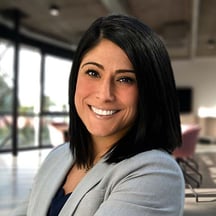Q&A with symplr President Nicole Rogas: Healthcare Operations Trends

 We asked symplr's top executives to share their outlook for healthcare operations technology.
We asked symplr's top executives to share their outlook for healthcare operations technology.
symplr President Nicole Rogas responds to questions about healthcare operations, the symplr customer journey, and the recent symplr Compass Survey of CIOs at top U.S. health systems.
Get the symplr Compass Survey Report
What customer trends keep you excited about the future of healthcare?
NR: I am just naturally passionate about healthcare and creating more efficiency. However, there are a few trends that get me incredibly excited. The first is the rise of consumer-driven healthcare. We've seen this evolution in almost all other industries, and post pandemic, it has come to healthcare in a way that’s been fast and furious. That's not going to change and in fact will only continue to grow as healthcare consumers approach care with a “retail” mindset and demand more from their providers. It’s an exciting time to work in healthcare IT and healthcare operations specifically.
Second, healthcare workforce shortages are certainly not something to be excited about. However, it is really the new normal and I’m motivated because symplr has solutions that can have a real impact in workforce management, talent acquisition, and employee retention for health systems. I think we're in a place where we recognize that workforce shortages are not a trend but are here to stay. Healthcare collectively understands that we’ll have to operate under the assumption that qualified providers and staff will be difficult to find, hire, and retain. As a result, healthcare operations software that creates efficiencies by optimizing staff and resources will be essential.
I’m also excited to be able to positively impact healthcare operations. We at symplr, and everyone in healthcare tech, understand that our roles are to enable others to be more efficient so that more time is spent on patient care. For example, we streamline processes for symplr customers by enabling automation where possible—that’s more important than ever in enabling clinicians and staff to do what they do best, and that’s care for patients, not perform more administrative tasks.
In symplr's Compass survey, 41% of CIOs cite financial pressure as a top threat. How can symplr help?
NR: As we enter the new year, we’re acutely aware that the financial pressure on our healthcare customers—CIOs, CFOs, and all administrators and leaders—is greater than ever and the stakes are high. symplr can make an impact on an organization’s financials. Through software and technology, we are helping to ensure that our customers’ employees are as efficient as they can be. Optimized healthcare operations—whether it’s the software itself or the processes and policies the technology encompasses—allow staff to focus on patient-centric responsibilities. We help streamline or automate tasks within areas from provider enrollment to the staffing and scheduling of the workforce, which is one of the toughest things, as we addressed earlier. And by helping healthcare organizations better manage their supply chain spending and contracts enterprise wide, symplr has a tangible impact on their finances. All of the software and services we offer are designed to create efficiencies and preserve resources so money can be reinvested in places directly related to the delivery of fantastic patient care.
What three symplr accomplishments from the past year are you most proud of?
NR: The first is our focus on the customer journey, which entailed bringing together our teams, better aligning our goals, and organizing and clarifying each role to create a delightful customer experience. And that is by far the largest accomplishment in the past year.
Very closely following that is the structural improvements we’ve made to our customer communications and outreach to our customers. I'm so proud of the output: straightforward and clear messaging and strategies that align directly with the things that we've heard straight from our customers. From the development of customer councils to our on-site meetings and initiatives with our partners at KLAS Research that affect customers—I’m delighted about how we’ve been able to translate feedback and data received into actions that better meet our customers’ needs.
Last, I'm really proud of the pace at which we operate at symplr. We are quick to make adjustments and improvements to our operating processes and strategies. We don’t deliberate endlessly but we do have open and honest conversations. And then we very quickly run forward and make the changes we need to be successful. I'm just so proud of how we've been able to sustain growth and sustain the pace to ensure that, at the end of the day, our employees and our customers get the best experience possible.
What are three things that customers can expect from symplr in the new year?
NR: First and foremost, our customers can anticipate proactive outreach. symplr has had incredible growth in the last several years and at times that has meant different experiences for different customers. But we've listened and set the goals to be more proactive and more consultative in our customers’ journey with symplr.
Customers can also expect continued progress in what we call our “connected enterprise strategy,” and that’s to provide software and services that not only help them operate but gives users a seamless experience. Our engagement with customers will continue to get better and better. We have spent a lot of time this year creating clarity around roles and responsibilities within our customer-facing teams to ensure each individual and team knows what their responsibility is to the customer, and to ensure that any handoff or transition throughout the customer journey is as seamless as possible. As a result, our customers will experience a more consultative approach from symplr than they have before.
Lastly, everyone can expect that symplr will continue to grow and keep bringing great ideas, software, and strategies to the healthcare operations space.
